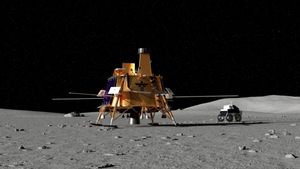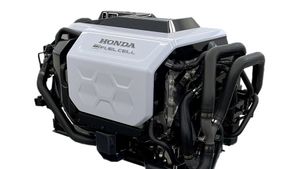JAKARTA - To peer deeper into the Sun, NASA launched the Parker Solar Probe (PSP) in 2018. Now, this Wow has flown quite close to the star in the Solar System.
PSP was launched to detect the fine structure of the solar wind, near where it was produced on the surface, revealing missing details as the wind came out of the coronal as a uniform explosion of charged particles.
This mission, such as seeing bursts of water emitting from the shower. The coronal hole is an area where magnetic field lines emerge from the surface without turning back inside, thus forming an open field line that extends outward and fills most of the space around the Sun.
Usually, the holes were at the poles during the quiet period of the sun, so that the fast solar wind they produced did not hit Earth.
However, when the Sun becomes active every 11 years when its magnetic field rotates, these holes appear all over the surface, producing solar wind bursts directed directly at Earth.
PSP has succeeded in detecting high-energy particle fluxes. The flow, suitable for supergranulation, flows in a coronal hole, indicating a fast area of solar wind origin.
Understanding how and where the solar wind comes from will help predict solar storms, in addition to producing beautiful auroras on Earth, can also damage satellites and power grids.
"Wind brings a lot of information from the sun to Earth, so understanding the mechanism behind the solar wind is important for practical reasons on Earth," said Professor of Physics, Stuart D. Bale, in a paper published in the journal Nature last week.
"It will affect our ability to understand how the sun releases energy and drives geomagnetic storms, which are a threat to our communication network," he added.
The scientists' analysis states that the coronal hole is like a shower head, in the form of bursts with roughly the same distance emerging from the bright spot where magnetic field lines enter and exit the sun's surface.
Scientists argue, when oppositely directed magnetic fields pass through each other in this funnel, which can reach 18,000 miles, the terrain often breaks and reconnectes, throwing charged particles out of the Sun.
PSP detected particles moving 10 to 100 times faster than the average solar wind, scientists concluded the wind could only be generated through this process, called magnetic reconnection.
"The big conclusion is that it is this magnetic reconnection within the structure of the funnel that provides a source of energy for fast solar winds," Bale said.
It doesn't just come from everywhere in a coronal hole, it is substructured inside a coronal hole into this supergranulation cell. It comes from a small collection of magnetic energy associated with convex flow. Our results, in our opinion, are strong evidence that reconnection is doing that," he added.
The funnel structure is likely to correspond to a bright burst that can be seen from Earth inside a coronal hole. The sun is expected to reach a maximum of the sun by July 2025, which is why more reports of solar flares, northern and southern light are being seen in unexpected places.
Fortunately, PSP and separate missions of Solar Orbiter, are well prepared to observe the powerful power of the Sun, as quoted by Eurekalert and CNN International, Monday, June 12.
"There was concern at the start of the solar investigation mission that we would launch this object directly into the quietest and most tedious parts of the solar cycle," Bale said.
"But I think without it, we'll never understand this. It's going to be too messy. I think we were lucky because we launched it in a minimum solar condition," he said.
The English, Chinese, Japanese, Arabic, and French versions are automatically generated by the AI. So there may still be inaccuracies in translating, please always see Indonesian as our main language. (system supported by DigitalSiber.id)













